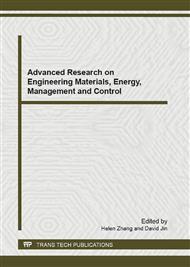[1]
H. Stone; J.L. Sidel, Sensory Evaluation Practice, Academic Press, Inc., San Diego, CA(1993).
Google Scholar
[2]
L.A. Zadeh. The concept of a linguistic variable and its applications to approximate reasoning. Information Sciences [J], 1975, 8, 8, 9 (Part I–III): 199–249, 301–357, 43–80.
DOI: 10.1016/0020-0255(75)90017-1
Google Scholar
[3]
J. Kacprzyk; S. Zadrozny. Computing with words in decision making: Through individual and collective linguistic choice rules, International Journal of Uncertainty, Fuzziness and Knowledge-Based Systems [J], 2001, 9(Suppl. ) 89–102.
DOI: 10.1142/s0218488501001010
Google Scholar
[4]
J. Lawry. A methodology for computing with words, International Journal of Approximate Reasoning [J], 2001, 28 51–89.
DOI: 10.1016/s0888-613x(01)00042-1
Google Scholar
[5]
R. Degani;G. Bortolan. The problem of linguistic approximation in clinical decision making, International Journal of Approximate Reasoning [J], 1998 , 2, 143–162.
DOI: 10.1016/0888-613x(88)90105-3
Google Scholar
[6]
R.R. Yager. On ordered weighted averaging aggregation operators in multi-criteria decision making, IEEE Transactions on Systems, Man, and Cybernetics[J], 1988, 18, 183–190.
DOI: 10.1109/21.87068
Google Scholar
[7]
C.T. Chen . Applying linguistic decision-making method to deal with service quality evaluation problems, International Journal of Uncertainty, Fuzziness and Knowledge-Based Systems[J], 2001, 9 (Suppl. ) 103–114.
DOI: 10.1142/s0218488501001022
Google Scholar
[8]
L. Martı´nez; J. Liu; J.B. Yang . A fuzzy model for design evaluation based on multiple-criteria analysis in engineering systems, International Journal of Uncertainty, Fuzziness and Knowledge-Based Systems[J], 2006 , 14 (3) 317–336.
DOI: 10.1142/s0218488506004035
Google Scholar
[9]
A.C. Marquez; C. Blanchar. A decision support system for evaluating operations investments in high technology business, Decision Support Systems[J], 2006, , 41 (2) 472–487.
DOI: 10.1016/j.dss.2004.08.012
Google Scholar
[10]
Jime´nez, S. Rı´os-Insua, A. Mateos. A decision support system for multi-attribute utility evaluation based on imprecise assignments, Decision Support Systems[J], 2003, 36 (1) 65–79.
DOI: 10.1016/s0167-9236(02)00137-9
Google Scholar
[11]
McEwan, J. A.; Heinio, R. etc. Proficiency testing for sensory ranking panels: measuring panel performance. Food Quality and Preference[J], 2002, 14, 247–256.
DOI: 10.1016/s0950-3293(02)00083-6
Google Scholar
[12]
McEwan, J. A.; Hunter, E. A.; Van Germert, L. J., & Lea, P. Proficiency testing for sensory profile panels: measuring panel performance., Food Quality and Preference[J], 2002, 13, 181–190.
DOI: 10.1016/s0950-3293(02)00022-8
Google Scholar
[13]
F. Herrera;L. Martı´nez. A 2-tuple fuzzy linguistic representation model for computing with words, IEEE Transactions on Fuzzy Systems[J], 2000, 8 (6) 746–752.
DOI: 10.1109/91.890332
Google Scholar
[14]
R.R. Yager. On ordered weighted averaging aggregation operators in multi-criteria decision making, IEEE Transactions on Systems, Man, and Cybernetics[J]1988, 18, 183–190.
DOI: 10.1109/21.87068
Google Scholar
[15]
GUO Ya-jun; YAO yuan; YI ping-tao. A method and application of dynamic comprehensive evaluation. Systems Engineering-Theory & Practice[J], 2007, (10), 155-159.
Google Scholar


